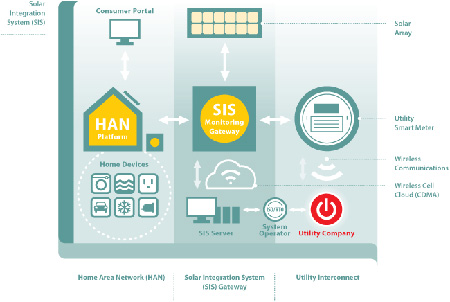Can stored solar power at the residential level help to make the smart grid smarter? According to Sunverge, the answer is ‘yes.’ The company’s new Solar Integration System (SIS) came to our attention via Pacific Housing’s new 2500 R Street affordable housing project slated for Sacramento, California, where it will be a key feature in the development’s projected LEED profile.
The system works, essentially, by allowing solar energy to be stored at home, and released by the utility company during times of peak demand. This is financially significant to both homeowners and utilities, since–as part of the global push toward reduced electricity demand– consumers are paying increasingly higher costs for energy used during peak hours under “time-of-use” billing structures. Peak solar generation typically occurs in the afternoon, several hours before peak energy demand. Because the Sunverge SIS captures solar energy when it’s most abundant and stores it for use when the cost of grid-tied power spikes, it can effectively shift a household’s load from higher- to lower-priced power.

The Sunverge SIS includes a residential, grid-tied photovoltaic solar array connected to an inverter that converts DC energy into AC energy coupled with a Lithium-Ion (Li-Ion) battery that stores captured energy. A key component of the system is the SIS Data Processing Gateway (SDPG), which enables electric utilities with smart grid programs to release that energy to the household when it’s most needed.
With more households running such systems, utility companies can aggregate SIS-stored energy in addressing various challenges that arise in meeting a district’s overall energy needs, improving power quality, responsiveness, reliability, efficiency and scalability.
All of this may sound like something that should have come into being with the very first smart meter deployed. But until recently, the cost of Li-Ion batteries was too high to make such a system feasible. With the advent of mass-produced electric vehicles like the Nissan Leaf and Chevy Volt, that has changed, as economies of scale have decreased the cost of production. Likewise, the rise of solar power worldwide in the past few years has helped to drive down the cost of solar cells–two factors that converge in Sunverge’s vision for affordable, grid-tied distributed solar.
Kenneth Munson, President of Sunverge Energy, sees broad potentials for SIS technology as utilities across the country implement smart grid technology–both to update antiquated infrastructure and provide more juice for electric vehicles–while seeking ways to bring on more renewable energy.
“Industry experts estimate global spending on renewable smart grid technologies at $200 billion between 2008 and 2015,” he told us. “Included in the smart grid technology investment, spending on grid-based energy storage is estimated to reach $4.1 to $8.3 billion by 2016.” Coupled with broad advancements in grid-based energy storage technologies, he sees applications for the SIS in the retrofitting of existing homes as well as in addressing energy storage needs for multi-familiy housing, communities, and schools, as well as commercial and industrial applications.
Sunverge’s partnership with Pacific Housing–the developers behind Sacramento’s 2500 R Street affordable housing project–evolved through a series of conversations between Munson and Mark A. Wiese, the organization’s president. These conversations centered on the potential for grid-based energy storage to create additional value for Pacific Housing (i.e., lower maintenance and construction costs) and the organizaiton’s vision to develop affordable homes with low carbon footprints courtesy of leading edge green technology.

By leveraging storage to yield the maximum benefit of captured energy, the Sunverge SIS will allow Pacific to supply each home with a smaller solar array than would otherwise be necessary to provide for that household’s need. To power a typical residence, by way of example, a traditional 4 kilowatt photovoltaic system costs approximately $34,000 installed and saves 30 to 50 percent in annual energy costs. A SIS, according to Sunverge, meets the same demand for approximately $24,000 to $28,000 and saves 50 to 70 percent annually. At 2500 R Street, that means lower up-front costs for Pacific Housing and greater savings for homeowners.
Does Pacific Housing have plans to utilize Sunverge’s SIS technology in future grid-tied affordable housing projects? Wiese responded by saying that yYes, we are working on gaining site control for two other 2500 R plan developments in the greater Sacramento Area as well as designing and modeling Sunverge’s SIS system on our existing affordable multifamily housing projects.” The first of these retrofit projects involving existing Pacific Housing projects is slated for launch this summer.